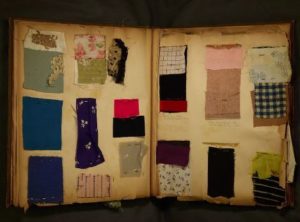By Emma Sherriff
 Research conducted by the Digital Humanities (DH) team at a private ancestral home, Culver House near Exeter led to a unique discovery of a Victorian dress album amongst a personal collection.
Research conducted by the Digital Humanities (DH) team at a private ancestral home, Culver House near Exeter led to a unique discovery of a Victorian dress album amongst a personal collection.
Nineteenth Century dress fabric samples are adhered in the pages accompanied by original annotations, sketches and documents relating to the society events to which the garments were worn. Fabric inserts of a selection of origins sit amongst haberdashery and fabric orders, and lists compiled by Rose Hobart, the creator. The album is one of six of its kind held in collections internationally. I have been working to digitally preserve and open up access to the album for research purposes, including writing a detailed AHRC Technical Plan for the digitisation of the resource.
Initial sample digitisation of the album as an object has been undertaken, using photogrammetry techniques to produce a draft 3D model and digitisation of fabric sample texture using Reflectance Transformation Imaging (RTI) techniques. Both have led to some interesting initial digital outputs of the album.
Visit our SketchFab site to view the 3D model: https://sketchfab.com/3d-models/victorian-dress-album-071bd2a6a290480198b854cba5019cc5
Follow the link below to view the RTI sample, click on the lightbulb and zoom to discover the fine detail: http://humanities-research.exeter.ac.uk/rti/fabricsample/
The purpose of the research is to understand the album, its construction and prior handling with high resolution photography whilst preserving the vulnerable original; and to analyse the fabric, for example the warp, weft, and the industries which produced the motifs and lace which adorn the fabrics.
RTI techniques can be used to digitise the surface texture of samples of interest across disciplines, and photogrammetry can be used for research purposes to understand any artefact or to educate groups, who would not otherwise be able to handle the vulnerable original.
